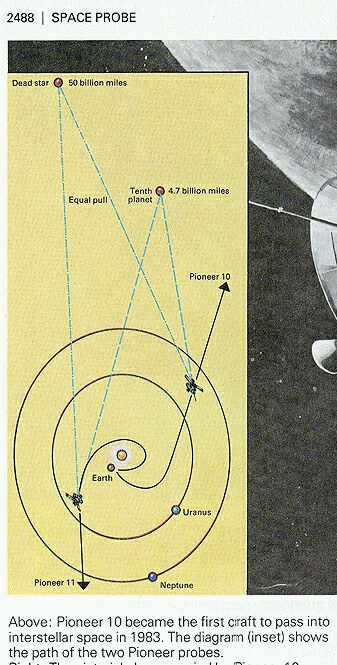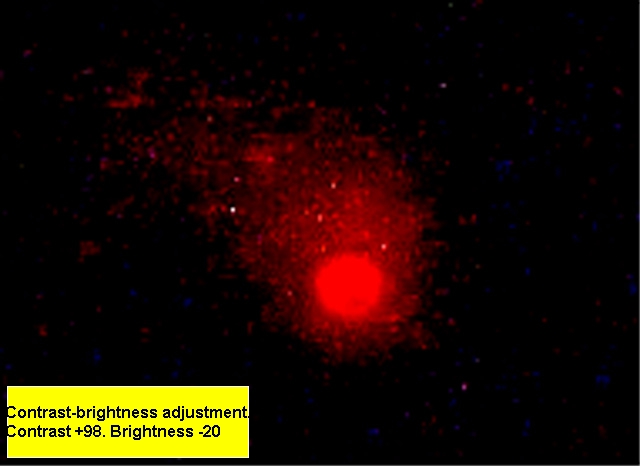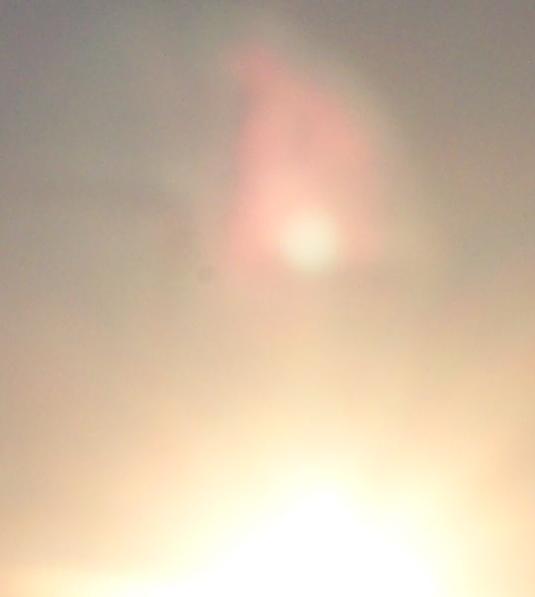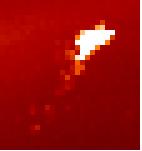Please do not reply to this Newsletter. You will likely get a response from a
machine, not Nancy! For feedback on the Newsletter or to correspond with
Nancy, click here instead.
Seeking Planet X
The search for Planet X in the modern era began centuries ago. Astronomers
noted that the outer planets in the solar system leaned out toward Orion,
perturbed out in that direction, and suspected a gravitational body there,
pulling. By 1981 they had computed the size and likely orbit tilt. Astronomy
magazine reported on the search for this mysterious gravitational body.
- Search for the Tenth Planet
December 1981
- Astronomers are readying telescopes to probe the outer reaches of our
solar system for an elusive planet much larger than Earth. Its existence
would explain a 160-year-old mystery. ... The pull exerted by its gravity
would account for a wobble in Uranus' orbit that was first detected in
1821 by a French astronomer, Alexis Bouvard. Beyond Pluto, in the
cold, dark regions of space, may lie an undiscovered tenth planet two to
five times the size of Earth. Astronomers at the U.S. Naval Observatory
(USNO) are using a powerful computer to identify the best target zones,
and a telescopic search will follow soon after. ... Van Flandern thinks
the tenth planet may have between two and five Earth masses and lie 50
to 100 astronomical units from the Sun. (An astronomical unit is the
mean distance between Earth and the Sun.) His team also presumes
that, like Pluto's, the plane of the undiscovered body's orbit is tilted
with respect to that of most other planets, and that its path around the
Sun is highly elliptical.
And in 1982 the search continued, as Newsweek magazine reported:
- Does the Sun Have a Dark Companion?
June 28, 1982
- When scientists noticed that Uranus wasn't following its predicted orbit
for example, they didn't question their theories. Instead they blamed the
anomalies on an as yet unseen planet and, sure enough, Neptune was
discovered in 1846. Now astronomers are using the same strategy to
explain quirks in the orbits of Uranus and Neptune. According to John
Anderson of the Jet Propulsion Laboratory in Pasadena, Calif., this odd
behavior suggests that the sun has an unseen companion, a dark star
gravitationally bound to it but billions of miles away. ... Other
scientists suggest that the most likely cause of the orbital snags is a
tenth planet 4 to 7 billion miles beyond Neptune. A companion star
would tug the outer planets, not just Uranus and Neptune, says Thomas
Van Flandern of the U.S Naval Observatory. And where he admits a
tenth planet is possible, but argues that it would have to be so big - a
least the size of Uranus - that it should have been discovered by now.
To resolve the question, NASA is staying tuned to Pioneer 10 and 11.
At that time, it was no secret that the Pioneer probes had been sent to search for
this mysterious planet. The New Science and Invention Encyclopedia
published by H.S. Stuttman in Westport, Connecticut included a graphic of the
Pioneer trajectories vis-a-vis the presence of a theoretic binary companion to
our Sun and a rogue planet traveling between the two suns.

The role of the Pioneer probes and infrared balloons sent up above the Earth's
atmosphere were openly discussed in 1981 and 1982. As Astronomy magazine
reported:
- Searching for a 10th Planet
October 1982
- NASA has been recording velocities for a year now and will continue
for as long as necessary. This past spring, it appeared that budget cuts
might force the end of the Pioneer project. The space agency now
believes that it will have the money to continue mission operations.
Next year, the JPL group will begin analyzing the data. By the time the
Pioneer experiment shows results, an Earth-orbiting infrared telescope
may have discovered the body. ... Together, IRAS and the Pioneers will
allow astronomers to mount a comprehensive search for new solar
system members. The two deep space probes should detect bodies near
enough to disturb their trajectories and the orbits or Uranus and
Neptune. IRAS should detect any large body in or near the solar system.
Then they found something. On December 31, 1983 the mysterious Planet X
was discovered by the IRAS team. The discovery hit the news in an article on
the front page of the Washington Post.
- Mystery Heavenly Body Discovered
December 31, 1983
- A heavenly body possibly as large as the giant planet Jupiter and
possibly so close to Earth that it would be part of this solar system has
been found in the direction of the constellation Orion by an orbiting
telescope aboard the U.S. infrared astronomical satellite. So mysterious
is the object that astronomers do not know if it is a planet, a giant
comet, a nearby "protostar" that never got hot enough to become a star,
a distant galaxy so young that it is still in the process of forming its
first stars or a galaxy so shrouded in dust that none of the light cast by
its stars ever gets through. "All I can tell you is that we don't know what
it is," Dr. Gerry Neugebauer, IRAS chief scientist for California's Jet
Propulsion Laboratory and director of the Palomar Observatory for the
California Institute of Technology said in an interview.
-
- The most fascinating explanation of this mystery body, which is so cold
it casts no light and has never been seen by optical telescopes on Earth
or in space, is that it is a giant gaseous planet, as large as Jupiter and
as close to Earth as 50 billion miles. While that may seem like a great
distance in earthbound terms, it is a stone's throw in cosmological
terms, so close in fact that it would be the nearest heavenly body to
Earth beyond the outermost planet Pluto. "If it is really that close, it
would be a part of our solar system," said Dr. James Houck of Cornell
University's Center for Radio Physics and Space Research and a
member of the IRAS science team. "If it is that close, I don't know how
the world's planetary scientists would even begin to classify it."
The mystery body was seen twice by the infrared satellite as it scanned
the northern sky from last January to November, when the satellite ran
out of the supercold helium that allowed its telescope to see the coldest
bodies in the heavens. The second observation took place six months
after the first and suggested the mystery body had not moved from its
spot in the sky near the western edge of the constellation Orion in that
time. "This suggests it's not a comet because a comet would not be as
large as the one we've observed and a comet would probably have
moved," Houck said. "A planet may have moved if it were as close as 50
billion miles but it could still be a more distant planet and not have
moved in six months time.
Whatever it is, Houck said, the mystery body is so cold its temperature
is no more than 40 degrees above "absolute" zero, which is 459 degrees
Fahrenheit below zero. The telescope aboard IRAS is cooled so low and
is so sensitive it can "see" objects in the heavens that are only 20
degrees above absolute zero. When IRAS scientists first saw the mystery
body and calculated that it could be as close as 50 billion miles, there
was some speculation that it might be moving toward Earth. "It's not
incoming mail," Cal Tech's Neugebauer said. "I want to douse that idea
with as much cold water as I can."
While the IRAS team struggled to explain just what they had found, they were
quick to point out that it was not "incoming mail". But how could they say that
if they didn't know quite what it was? The quick assurance that the discovery
was not "inbound" was a clue that panic was just under the surface. The fear
was that the public would panic and make demands on the government, and
thus a cover-up was quickly put into place. All talk of the true purpose of the
Pioneer probes and those perturbations on outer planets that had been observed
for centuries was halted.
ZetaTalk Comment 2/15/1996: The discovery of solid proof so stunned most
of those involved in the search that their guard was dropped, and thus the
reports such as the 1983 Washington Post front page article. Interest in
Planet X was roaring along going into the 1983 IRAS search. Had Planet X
not been found, interest might still be roaring along, in the media, that is.
When the blanket of suppression was dropped on the media and major
observatories, who know just where Planet X is at all times these days, it
took some time for an explanation for the silence to be concocted. Thus one
finds the strange silence that lasted almost a decade following the Planet X
discovery in 1983.
Inbound Denial
Enter ZetaTalk in 1995, with its explicit instructions on where folks could look
in the night sky to see the inbound Planet X. These instructions included a
graphic of the path as viewed from Earth over the years, and the coordinates in
the sky, which are known as RA (right angle, or to the side along the horizon)
and Dec (declination, or up into the dome).

Was it found at those coordinates? Indeed it was. First several observatories
sighted it in 2001. The first observation in France on February 7, 2001 was by
an astronomer who was quickly silenced.
The Neuchatel observatory got it. They are very excited, wondering if it is a
comet or a brown dwarf, through the latest coordinates you gave. I'm going
to ask for further details. The daughter of the astronomer reports that they
suspect a comet or a brown dwarf on the process to become a pulsar since it
emits "waves".
The second sighting was at the historic Lowell observatory in Flagstaff,
Arizona on April 1, 2001. This team met some resistance, almost as though
word had gone out to observatories and astronomers to block viewing at the
ZetaTalk coordinates.
I reserved the historic Clark 24" telescope for my own private viewing. As it
turns out, the telescope operator was unable to point the Clark in the
direction of Orion because there was a scaffold in the way which only the
operator's supervisor was allowed to move. I don't suspect conspiracy on
this point but, heck, who knows ;). In any event the operator was determined
to give me my money's worth and he opened up the McAllister telescope, a
newer but smaller scope with a 16" mirror (built in 1963). We trained the
big do-hickey on the coordinates given for April 1 2001. Lo and behold,
there appeared a faint blip not too far off center. I looked long and hard but
wasn't sure if I was imagining it or not. I asked a friend who had come along
to take a look and told him what to look for. He said he maybe saw
something. I asked the operator if he would look in the same fashion. He
looked carefully for a couple of minutes and confirmed what I saw. I took
another look to satisfy myself. Yes, there was definitely something there. I
had the operator center the telescope on the faint object so that we could get
the coordinates more precisely and then I checked a third time to make sure
we were talking about the same thing. We were; the elusive blip was
centered now.
The third sighting was at the Gordon McMillan observatory in Vancouver,
Canada on April 8, 2001, and here the blocking attempts were obvious.
I and a friend of mine made it down to the Gordon Macmillan Southam
Observatory tonight and had what I believe was a very strange experience. I
called the observatory around 7:30 and spoke to some guy and asked if it
was okay to look at a object near the constellation Orion. He said that there
was some large pipe that had been placed in front of the observatory and
was not sure if he could swing the telescope in that direction but that we
might be able to see something. He said optimal time to look would be about
9:30. Finally it's 10:00 and I go outside and ask him when he can move the
telescope. He then off handily replies that Orion has gone below the horizon
and we wouldn't be able to see anything anymore. When I read him the
coordinates (it was fairly dark inside) he entered the first in wrong, and
after I corrected him only entered into three decimal places and rounded up
when he should have rounded down. He remarked that the other decimal
places were not necessary. I didn't persist because I felt it would be in the
ball park. He then moved the telescope, went over to the eye piece (it was so
fast I wasn't even sure he looked), came back, muttered something about
trees, moons, horizons or something, entered in new coordinates, moved the
telescope and left to the other side and began talking to some other people
before I could even say a word.
I was quite perplexed and wasn't sure what had happened but I wasn't going
to give up. I approached him again and asked him if he looked at those
coordinates. He said he had, nothing there and tried to brush me off. I asked
him if he could move it back so I could take a look. He then brought out some
big star chart book, opened it up, pointed to the very bottom of the map on
the page and said it was very low. I then persisted if that was the right area
and he then changed and pointed to near the top of the map. I said we should
be able to see it then no problem and again directly asked if he could move it
to those coordinates so I could take a quick look. It was like he was
speechless, looking around blankly, brought out another book, opened it,
started babbling about nothing until I stopped him and told him that we've
been waiting two hours and could we please take a look. He then re-enters
the coordinates which I read off again and moved the telescope. I go to take
a look. I asked him if that darkish spot was anything or just an optical flaw
and he said it was optical (we were viewing Saturn earlier and I did not
recall seeing any dark spot and I thought it was strange to have such a large
flaw on the eyepiece of a $200,000 piece of equipment). He then handed my
friend a hand held controller that had about six dials or buttons on it and
said he could move the telescope around and walked away - no instructions.
This Vancouver astronomer later admitted, off the record, that they were aware
of Planet X and were "looking at it all the time." Sighting Planet X at the
ZetaTalk coordinates then moved to infrared imaging, which first occurred in
Florida on December 5, 2001 and then in France on January 19, 2002 at the
Haute-Provence observatory. A third team in Africa reserved a large
observatory scope in South Africa for a December 19, 2001 viewing but they
were refused a look when they arrived at the observatory.
After we drove 1,400 km to the observatory, (having made arrangements),
they refused to let us have a look at Nibiru. The astronomer at the
Sutherland Observatory (SAAO - the biggest in the Southern Hemisphere -
74" telescope) - after several telephonic confirmations refused permission to
view.
In the fall of 2002, when Orion was again visible in the night sky, CCD
imaging of the inbound complex was done dozens of times. The complex was
tracked as it moved in accordance with the ZetaTalk coordinates, and had the
appearance of a dull star not on the star charts. On February 26, 2003 pilots
high above the atmosphere in the clear air over the Amazon basin reported
seeing the complex with 10X binoculars.
While flying back to Houston from Rio de Janero yesterday [Feb 26th], I
believe that I was able to see the Nibiru complex w/10 power binoculars. It
appeared as a very diffuse area that looked very dimly backlit. We were out
over the Amazon Basin. The atmosphere was very clear above us. The other
two pilots I was flying with were also able to see it with the binoculars.
Reports then flooded in, and I myself viewed it on the evening of March 26,
2003 as a pulsing dull red spot just below Alderbaran, to the right of Orion.
Then the flood of photos started. One of the best was one taken on April 13,
2003 in North Carolina in the evening sky, and another taken on July 29, 2003
in Pennsylvania during daylight (as Planet X was then approaching the Sun).
Both photos showed the double helix tail of legend swirling behind the inbound
Planet X. The ancient Sumerians termed Planet X the "planet of the crossing"
and depicted it as a winged globe in part because of the double helix the tail
presented when the complex was inbound.



ZetaTalk Comment 4/5/2008: This [North Carolina] photo came on the
scene at a time when Planet X was visible to the naked eye in the nighttime
sky, March-April, 2003. Many were viewing it out near Orion at the RA and
Dec we had given, as a pulsing red blur which was not any star on the
charts. Nancy has many verbal descriptions of this, and viewed this herself
on March 26, 2003. The photo in question was taken with telescopic lens, a
zoom, and is valid and real. It was attacked ferociously after Nancy put it on
her website, as it was such a provocative threat. Some professional
debunkers claimed they were the photographer, and that it was a fraud. The
real photographer was so threatened that he retreated and let the debunkers
have their way with his capture. Nevertheless, it stands as it does today, a
testimony to the accuracy of our prediction that Planet X would arrive when
and where it did. Kid A's contribution has survived and lives to tell the tale
of those exciting times.
And lest one be nervous about photos from uncertain sources, there are those
captures on the LASCO satellites, like this one on December 23, 2007 as
featured in the Newsletter at that time. There it is - Planet X with its flowing
tail. No planet was expected to be to the right of the Sun at the 2 o'clock
position on December 23, 2007. This is the Planet X complex, out near the Sun
and in the line of sight as viewed from the northern hemisphere.

Cover-up Lies
Now we hear from astronomers in Japan that we are once again looking for that
mysterious Planet X.
- Earth-Size Planet to Be Found in Outer Solar System?
March 17, 2008
http://news.nationalgeographic.com/news/2008/03/080317-new-planet.html
- A planet roughly the size of Earth could be tracing a vast, elliptical
orbit at the outer edge of our solar system-and astronomers in Japan
think they know where to find it. The presence of this unnamed body has
been suggested before. A huge number of objects are showing large
orbital eccentricities and elliptical orbits. But the extreme distance and
unusual orbit of the elusive "Planet X" have made it difficult to spot
even with the most advanced telescopes. The eight known planets in our
solar system are on very similar elliptical orbits and are all almost
within the ecliptic plane, the geometric plane that roughly describes
Earth's orbit around the sun. The new models, however, suggest that
Planet X is circling the sun on a 20 to 40 degree angle relative to the
ecliptic plane.
How is it that they could have missed it? They haven't. The illusion being
projected is that it is still out there and not yet arrived. Else the public will
panic! Asked about this Japanese initiative, the Zetas explained:
ZetaTalk Explanation 3/1/2008: At the start of ZetaTalk, when it first burst
onto the scene, there was a flurry of disinformation about the term "Planet
X." Every odd rock that NASA announced in the vicinity was termed "Planet
X" in some manner. Sedna was termed in this manner. That this confusion
over the term is again being promoted shows the fear in the establishment
that search engines will be used to locate ZetaTalk information. In this way,
typing the term "Planet X" into a search engine will bring up these types of
articles, diluting the ZetaTalk message, or so they hope.
You received this Newsletter because you subscribed to the ZetaTalk Newsletter service. If
undesired, you can quickly Unsubscribe.
|

